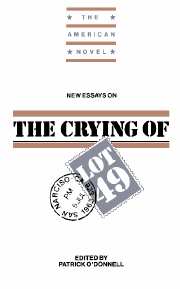Book contents
- Frontmatter
- Contents
- Series Editor's Preface
- 1 Introduction
- 2 Borges and Pynchon: The Tenuous Symmetries of Art
- 3 Toward the Schizo-Text: Paranoia as Semiotic Regime in The Crying of Lot 49
- 4 “Hushing Sick Transmissions”: Disrupting Story in The Crying of Lot 49
- 5 “A Metaphor of God Knew How Many Parts”: The Engine that Drives The Crying of Lot 49
- 6 A Re-cognition of Her Errand into the Wilderness
- Notes on Contributors
- Selected Bibliography
3 - Toward the Schizo-Text: Paranoia as Semiotic Regime in The Crying of Lot 49
Published online by Cambridge University Press: 12 January 2010
- Frontmatter
- Contents
- Series Editor's Preface
- 1 Introduction
- 2 Borges and Pynchon: The Tenuous Symmetries of Art
- 3 Toward the Schizo-Text: Paranoia as Semiotic Regime in The Crying of Lot 49
- 4 “Hushing Sick Transmissions”: Disrupting Story in The Crying of Lot 49
- 5 “A Metaphor of God Knew How Many Parts”: The Engine that Drives The Crying of Lot 49
- 6 A Re-cognition of Her Errand into the Wilderness
- Notes on Contributors
- Selected Bibliography
Summary
First and foremost, Thomas Pynchon's second novel, The Crying of Lot 49, is concerned with signs and their “reading” or interpretation. This would seem to be an obvious constant in Pynchon's fiction. In his first novel, V., signs proliferate — above all, the letter V and the V-shape — as one of the major characters, Herbert Stencil, attempts to link the appearances of a mysterious woman with episodes of violence and decadence in the history of the twentieth century. In Gravity's Rainbow, the central character, Tyrone Slothrop, as well as many of the minor characters are particularly adept at reading signs — not only shapes in the sky but mandalas, whip scars, reefers, trout guts, and Tarot cards amid a whole spectrum of semiotic material. The Crying of Lot 49 differs from these two much longer flanking novels in that its focus is confined to the experience of one character, Oedipa Maas, or rather, to a kind of specific reading and interpretation of signs that for the moment we can simply call “paranoia.” In reading the novel, however, we are compelled to consider paranoia less as a mental aberration than as a specific “regime of signs,” that is, as a basic type of organization of signs in which the semiotic or signifying potential is dominant.
- Type
- Chapter
- Information
- New Essays on The Crying of Lot 49 , pp. 47 - 78Publisher: Cambridge University PressPrint publication year: 1992
- 1
- Cited by

